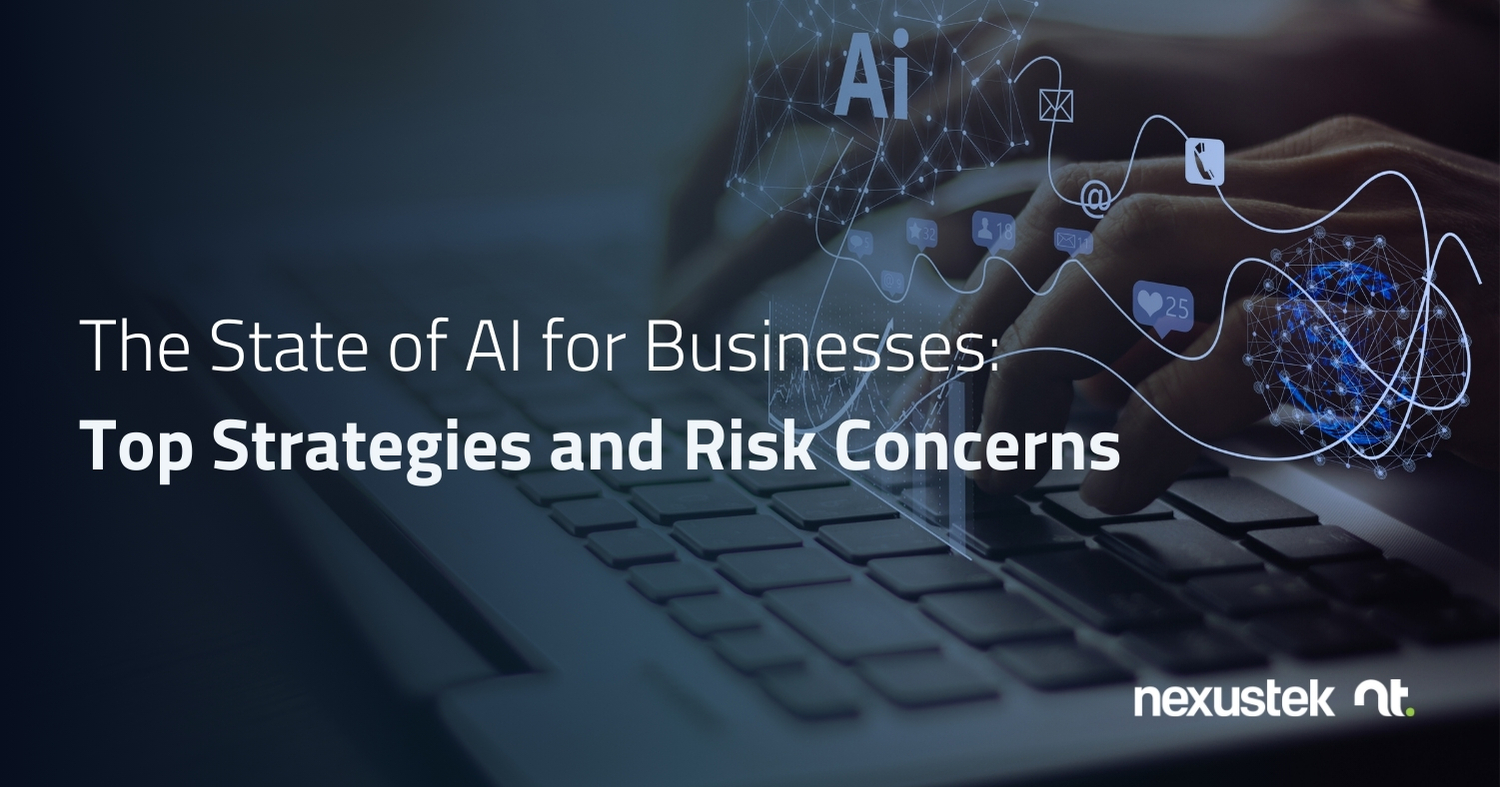
The State of AI for Businesses: Top Strategies and Risk Concerns
If you’re like us, you’ll probably have to admit that when generative AI first hit the scene, you used it mostly for tasks like writing hip-hop lyrics about business meetings in the style of Snoop Dogg or composing Shakespearean tragedies about the challenges of interdepartmental collaboration. But even those of us who first adopted generative AI with whimsy began to see very quickly just how powerful this new tool could be in the workplace.
The race is now on to strategically integrate generative AI and other AI tools in ways that allow businesses to keep up with and ideally outpace their competition. Already, 59% of businesses in the small to mid-sized class (i.e., < 1,000 employees) report that AI has made an impact on their business1.
Illustrating the primacy of AI in current business strategy, a recent study found that the #1 strategic initiative among small to mid-sized businesses for 2024 is to increase technology investments to automate and streamline operations2. In line with that focus, trends in AI use are beginning to emerge. These are the subject of the next section.
Top AI and Automation Strategies for 2024
Customer Service
AI has already been a boon to customer service, with 63% of retail organizations now using some form of AI3. Use of AI can help businesses respond to customers more quickly, enhance personalization, and power greater efficiency in customer service. Chatbots are a common application of AI to customer service, providing 24/7 access to answers to common questions, product recommendations, and complaint resolution. Some businesses use AI to analyze customer feedback, allowing them to improve customer satisfaction and thereby build loyalty.
Operations
Another major area where AI can exert strategic leverage is operations. Businesses were quick to identify AI’s potential for improving their efficiency, productivity, and profitability, and over 40% of business leaders already report increased productivity through AI automation4. AI is being used by manufacturers to optimize production, to reduce costly waste, and to prevent profit-eroding downtime. AI can also help retailers to more accurately manage inventory, logistics, and delivery.
Data Analysis
AI tools are also being used to support data analysis. AI can process and analyze large datasets to help businesses derive data-based insights and predictions, which support better decision making. For example, marketing departments are using AI to segment customers, forecast demand, and evaluate marketing campaign performance. Finance professionals are using AI to automate accounting processes and to detect fraud.
Product Development
AI is also showing promise in the area of product development. AI can help businesses with development of products and services that meet customer needs in innovative ways, enhancing competitive advantage. For example, AI can help product development teams to generate new ideas, to test prototypes, and to optimize features in alignment with customer expectations.
Human Resources
A business is only as good as its employees, and AI can help with this as well. Human resources departments are increasingly adopting AI to support their hiring and retention efforts. For example, AI can help to screen resumes to identify the best candidates for open positions, and it can even conduct interviews and evaluate candidates. AI can also support employee development and retention by helping managers to provide feedback, coaching, and training to employees.
Concerns About AI-Related Risk to Businesses
Although 62% of business leaders express excitement about AI’s potential, 30% report feelings of uncertainty and 10% are downright anxious5. A common concern relates to the potential risks of AI when used in the business context. In businesses with fewer than 1,000 employees, the top 3 concerns about AI are: (a) concerns about information security, (b) concerns about data privacy, and (c) unintended consequences6.
Concerns like these are well justified, as generative AI can pose serious risks without appropriate guard rails. Recommendations are:
AI Policy
It is well known among technology professionals that any use of shadow IT by employees poses a risk to data privacy and security. By “shadow IT,” we mean software and other technologies that are adopted by employees without the knowledge and approval of their company’s IT department. Beyond the risks created by shadow IT (e.g., ransomware attacks), generative AI can pose unique data privacy and security risks due to its use of input data to “learn.”
Because employees may input proprietary information, customer information, or employee information into generative AI tools, a clear AI policy is now a must-have for businesses. Before any use of generative AI for business purposes, a business should specify which AI platform(s) may be used, acceptable AI use, and unacceptable AI use.
Cybersecurity Assessment
Businesses that are uncertain of how integrating AI technologies into their infrastructure may impact security should consider obtaining a cybersecurity assessment from a qualified professional. A cybersecurity assessment helps businesses to better understand the state of their security posture, to identify any holes in their defenses, and to formulate strategies to patch any holes identified.
NexusTek is an early adopter of AI, offering expertise in risk management related to AI adoption, including AI policy and cybersecurity assessment.
.
Does your business need support to adopt AI tools effectively and securely?
References:
- SMB Group. (2024, January 4). 2024 top 10 SMB technology trends. https://www.smb-gr.com/wp-content/uploads/2024/01/SMB_2024-Top-10-SMB-Technology-Trends_v5_01-04-2024.pdf
- SMB Group. (2024, January 4). 2024 top 10 SMB technology trends. https://www.smb-gr.com/wp-content/uploads/2024/01/SMB_2024-Top-10-SMB-Technology-Trends_v5_01-04-2024.pdf
- Hawley, M. (2023, October 2). 10 AI customer experience statistics you should know about. CMSWire. https://www.cmswire.com/customer-experience/10-ai-customer-experience-statistics-you-should-know-about/
- , Matleena. (2024, January 8). 27 AI statistics and trends in 2024. Hostinger Tutorials. https://www.hostinger.com/tutorials/ai-statistics
- (2024, January). Now decides next: Insights from the leading edge of generative AI adoption. https://www2.deloitte.com/content/dam/Deloitte/us/Documents/consulting/us-state-of-gen-ai-report.pdf
- SMB Group. (2024, January 4). 2024 top 10 SMB technology trends. https://www.smb-gr.com/wp-content/uploads/2024/01/SMB_2024-Top-10-SMB-Technology-Trends_v5_01-04-2024.pdf